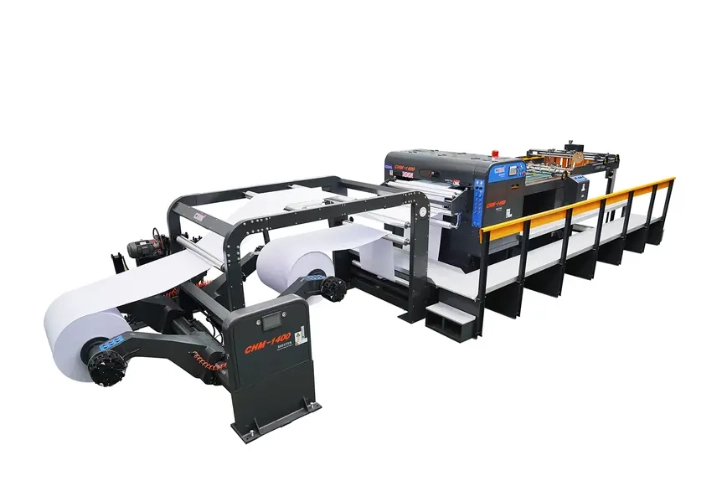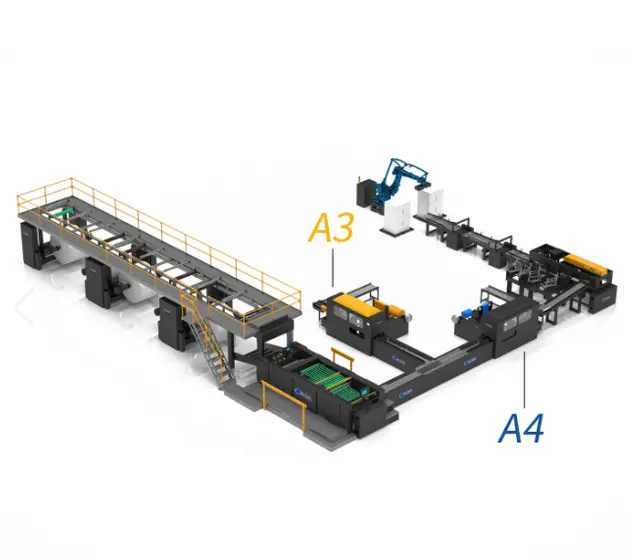 English
English- All
- Product Name
- Product Keyword
- Product Model
- Product Summary
- Product Description
- Multi Field Search
 English
English

Views: 190 Author: Site Editor Publish Time: 2025-08-26 Origin: Site











When it comes to modern converting and packaging industries, versatility in machinery is a game-changer. The question often arises among manufacturers and printers: Can one paper sheeting machine handle both thin tissue paper and thick board? The answer lies in understanding how today’s advanced paper sheeting machines are engineered, the technology they use, and how operators can fine-tune them for such a wide range of materials. This article explores the capabilities, benefits, and practical considerations of using a single sheeter for materials as delicate as tissue paper and as robust as thick board.
A paper sheeting machine is designed to convert large rolls of paper into precise sheets. It operates with a combination of high-speed rotary knives, precision tension control, and automated feeding systems. The best modern machines incorporate features that allow them to switch seamlessly between different paper weights and thicknesses, ensuring both accuracy and quality.
Thin tissue paper, often ranging from 17–40 gsm (grams per square meter), requires delicate handling to prevent tearing, wrinkles, or misalignment. On the other hand, thick board — which may exceed 350 gsm — demands high cutting force and stability. For a single sheeter to manage both, it must have adaptable tension settings, adjustable blade pressure, and intelligent control systems that respond to material differences in real time.

To understand whether one paper sheeting machine can handle both extremes of paper thickness, it’s important to examine the machine’s design parameters. A multi-purpose sheeter should have:
Adjustable Knife Pressure: Ensures the correct cutting force is applied for both thin and thick materials.
Variable Tension Control: Maintains paper alignment without stretching delicate tissue.
Precision Registration System: Keeps cutting accuracy consistent for high-end printing applications.
Automatic Speed Adjustment: Slower feed for fragile materials, higher speed for sturdier board.
Anti-Curl and Anti-Static Devices: Prevent curling or static cling in lightweight papers.
Without these features, switching between tissue paper and thick board could compromise output quality or even damage the material.
Operating a multi-material paper sheeting machine requires both mechanical adaptability and skilled operators. Switching from thin tissue paper to thick board involves several adjustments:
Blade Clearance and Sharpness – The blades must be sharp and set with the correct clearance to avoid tearing tissue or crushing board edges.
Feed Roll Pressure – Excessive pressure may wrinkle thin sheets, while insufficient pressure can cause slippage when cutting thicker materials.
Tension Calibration – Light tension for delicate materials, higher tension for heavy board.
Speed Control – Running tissue at lower speeds reduces tearing risk, whereas board can be processed at higher rates.
Waste Management – Thin paper produces lighter, more airborne waste, while thick board generates heavier trimmings.
With these adjustments, a single machine can reliably deliver precision-cut sheets regardless of material type.
| Parameter | Thin Tissue Paper (17–40 gsm) | Thick Board (350+ gsm) |
|---|---|---|
| Cutting Speed | Low to medium | Medium to high |
| Knife Pressure | Very low | High |
| Tension Settings | Light | Firm |
| Feeding Method | Gentle roller feed | Strong grip feed |
| Static Control | Essential | Optional |
| Curl Prevention | Required | Not critical |
| Operator Attention | High | Moderate |
This comparison illustrates the necessity for flexibility in settings and component durability when expecting a single paper sheeter to cover such a wide range of specifications.
There are clear benefits to investing in a versatile paper sheeting machine rather than maintaining multiple dedicated machines:
Space Saving – One machine occupies less floor space than two separate setups.
Reduced Maintenance Costs – Fewer machines mean fewer components to service.
Streamlined Workflow – No need to transfer rolls between machines.
Operator Familiarity – Staff become experts on one system rather than dividing skills.
Cost Efficiency – Initial investment may be higher, but operational savings over time are significant.
However, it’s worth noting that while one machine can be highly adaptable, production efficiency still depends on operator skill and maintenance discipline.
Despite technological advancements, there are still practical limits when expecting a single sheeter to handle extreme material differences:
Changeover Time – Switching between materials requires recalibration, which may cause downtime.
Blade Wear – Frequent shifts from soft to hard materials can accelerate blade wear.
Production Speed Compromise – Machines set up for versatility may not achieve the maximum throughput of specialized single-material sheeters.
Material Handling Risks – Without proper training, operators may cause damage to delicate sheets or create quality inconsistencies.
Acknowledging these challenges helps businesses make informed decisions when configuring their sheeting operations.

Q1: Will cutting both thin tissue and thick board reduce machine lifespan?
A: Not necessarily, as long as proper maintenance, blade care, and calibration are observed. High-quality machines are designed to endure varied workloads.
Q2: How long does it take to switch between paper types?
A: Depending on operator skill, changeovers can take 15–30 minutes, primarily for adjusting tension, blade pressure, and feed settings.
Q3: Is there a maximum thickness a sheeter can handle?
A: Each model has specific capacity limits, often ranging up to 500 gsm or more for premium designs.
Q4: Can automation features help reduce setup time?
A: Yes. Machines with programmable memory settings can store configurations for specific materials, significantly reducing changeover time.
So, can one paper sheeting machine handle both thin tissue paper and thick board? The answer is a confident yes, provided the machine is designed with versatility, adjustability, and operator-friendly controls. Modern high-precision commercial paper sheeting machines are capable of delivering flawless results across a wide spectrum of material weights, provided operators understand and respect the technical adjustments required.
For businesses seeking to maximize their investment, the ideal solution is to choose a robust, high-quality machine that balances flexibility with reliability. When properly maintained, such a system can replace multiple dedicated sheeters, reduce production bottlenecks, and improve overall operational efficiency — all while meeting the exacting standards of diverse printing and packaging projects.